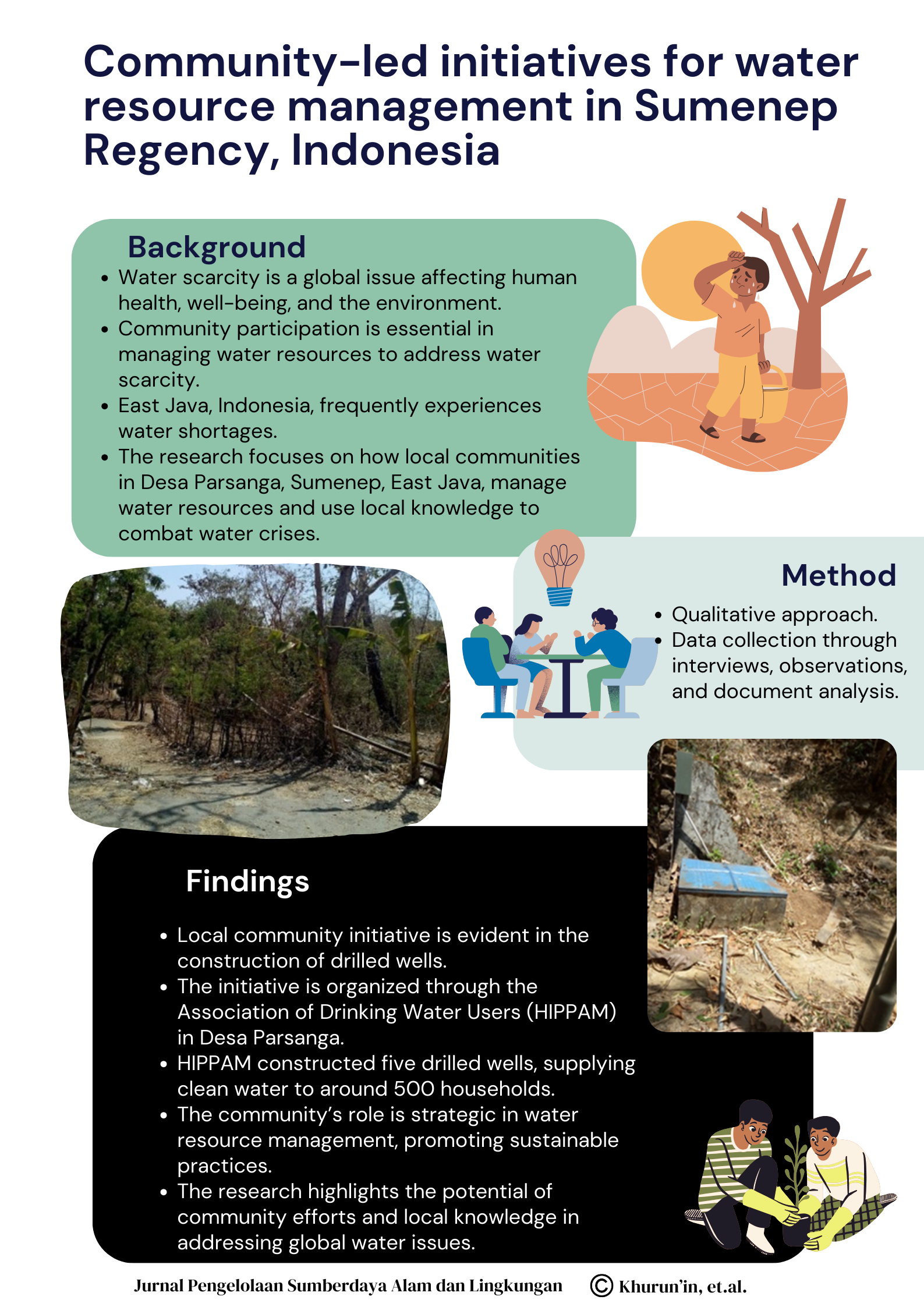Gerakan lingkungan dari bawah: inisiatif komunitas dalam pengelolaan sumberdaya air di Kabupaten Sumenep, Indonesia
Abstrak
Kelangkaan air adalah masalah global yang dapat mempengaruhi kesehatan dan kesejahteraan manusia serta lingkungan. Partisipasi masyarakat diakui sebagai aspek penting dalam pengelolaan sumberdaya air, khususnya dalam upaya mengatasi kelangkaan air. Di Indonesia, Jawa Timur merupakan salah satu provinsi yang sering mengalami kekurangan air. Penelitian ini bertujuan untuk mengeksplorasi bagaimana masyarakat lokal berpartisipasi dalam pengelolaan sumberdaya air dan memanfaatkan pengetahuan lokal mereka untuk mengatasi kerentanan krisis air bersih di Desa Parsanga, Sumenep, Jawa Timur. Penelitian ini menggunakan pendekatan kualitatif dan menggunakan wawancara, observasi dan analisis dokumen sebagai metode pengumpulan data. Hasil penelitian menemukan bahwa inisiatif masyarakat lokal ditunjukkan dalam partisipasi untuk pembangunan sumur bor. Partisipasi ini diwadahi dalam organisasi yang dibentuk oleh masyarakat lokal di Desa Parsanga sendiri yaitu HIPPAM (Himpunan Masyarakat Pengguna Air Minum). HIPPAM telah membangun lima sumur bor yang dapat menyuplai air bersih kepada kurang lebih 500 rumah tangga. Inisiatif ini menunjukkan bahwa masyarakat lokal memiliki peran strategis dalam pengelolaan sumberdaya air dan dapat mendorong praktik-praktik keberlanjutan. Penelitian ini memberikan wawasan mengenai potensi masyarakat dan pengetahuan lokal dalam mengatasi permasalahan air global.
Referensi
Adams EA, Byrns S, Kumwenda S, Quilliam R, Mkandawire T, Price H. 2022. Water journeys: Household water insecurity, health risks, and embodiment in slums and informal settlements. Soc Sci Med. 313(April). doi:10.1016/j.socscimed.2022.115394.
Arnstein SR. 1969. A Ladder of Citizen Participation. J Am Inst Plann. 35(4):216–224. doi:https://doi.org/10.1080/01944366908977225.
Bouncken RB, Qiu Y, Sinkovics N, Kürsten W. 2021. Qualitative research: extending the range with flexible pattern matching. Rev Manag Sci. 15(2):251–273. doi:10.1007/s11846-021-00451-2. https://doi.org/10.1007/s11846-021-00451-2.
Chakraborty S, Gasparatos A. 2019. Community values and traditional knowledge for coastal ecosystem services management in the “satoumi” seascape of
Himeshima island, Japan. Ecosyst Serv. 37(May). doi:10.1016/j.ecoser.2019.100940.
Daghagh Yazd S, Wheeler SA, Zuo A. 2020. Understanding the impacts of water scarcity and socio-economic demographics on farmer mental health in the Murray-Darling Basin. Ecol Econ. 169(November 2019). doi:10.1016/j.ecolecon.2019.106564.
Dinas Lingkungan Hidup Kabupaten Sumenep. 2019. Potensi Sumber Mata Air di Kabupaten Sumenep.
Echeverría JMA. 2022. Drivers of Adaptation to Water Scarcity: Extraction Capping in Field Experiments. Groundw Sustain Dev. 19(100827). doi:10.1016/j.gsd.2022.100827.
Gutiérrez D, Glückler J. 2022. Assisted network governance: An inclusive innovation to mitigate extreme water scarcity. Glob Environ Chang. 76(July 2021). doi:10.1016/j.gloenvcha.2022.102577.
Halimani T, Marandure T, Chikwanha OC, Molotsi AH, Abiodun BJ, Dzama K, Mapiye C. 2021. Smallholder sheep farmers’ perceived impact of water scarcity in the dry ecozones of South Africa: Determinants and response strategies. Clim Risk Manag. 34(March). doi:10.1016/j.crm.2021.100369.
Hamilton AB, Finley EP. 2019. Qualitative methods in implementation research: An introduction. Psychiatry Res. 280(August):112516. doi:10.1016/j.psychres.2019.112516.
Harik G, Alameddine I, Zurayk R, El-Fadel M. 2023. An integrated socio-economic agent-based modeling framework towards assessing farmers’ decision making under water scarcity and varying utility functions. J Environ Manage. 329(November 2022):117055. doi:10.1016/j.jenvman.2022.117055. https://doi.org/10.1016/j.jenvman.2022.117055.
Haryanto YD, Budiprabowo NA. 2022. Sebaran Spasial Wilayah Rawan Kekeringan Lahan Tanaman Padi Sebagai Upaya Manajemen Risiko Bencana Kekeringan Di Provinsi Jawa Timur. J Manaj Bencana. 8(1):1–14. doi:10.33172/jmb.v8i1.745.
Khanal G, Maraseni T, Thapa A, Devkota N, Paudel UR, Khanal CK. 2023. Managing water scarcity via rainwater harvesting system in Kathmandu Valley, Nepal: People’s awareness, implementation challenges and way forward. Environ Dev. 46(March):100850. doi:10.1016/j.envdev.2023.100850. https://doi.org/10.1016/j.envdev.2023.100850.
Licandeo F, Flores F, Feijoo F. 2023. Assessing the impacts of economy-wide emissions policies in the water, energy, and land systems considering water scarcity scenarios. Appl Energy. 342(March):121115. doi:10.1016/j.apenergy.2023.121115. https://doi.org/10.1016/j.apenergy.2023.121115.
Martinez-Alier J. 2014. The environmentalism of the poor. Geoforum. 54:239–241. doi:10.1016/j.geoforum.2013.04.019. http://dx.doi.org/10.1016/j.geoforum.2013.04.019.
Mavhura E, Mushure S. 2019. Forest and wildlife resource-conservation efforts based on indigenous knowledge: The case of Nharira community in Chikomba district, Zimbabwe. For Policy Econ. 105(May):83–90. doi:10.1016/j.forpol.2019.05.019.
Muttaqin MZ, Alviya I, Lugina M, Hamdani FAU, Indartik. 2019. Developing community-based forest ecosystem service management to reduce emissions from deforestation and forest degradation. For Policy Econ. 108(May). doi:10.1016/j.forpol.2019.05.024.
Qureshi ME, Hanjra MA, Ward J. 2013. Impact of water scarcity in Australia on global food security in an era of climate change. Food Policy. 38(December):136–145. doi:10.1016/j.foodpol.2012.11.003.
Sun Y, Nan Z, Yang W, Li L. 2023. Projecting China ’ s future water footprints and water scarcity under socioeconomic and climate change pathways using an integrated simulation approach. Clim Serv. 30(1):100385. doi:10.1016/j.cliser.2023.100385. https://doi.org/10.1016/j.cliser.2023.100385.
Wahyudi H. 2009. Kondisi dan Potensi Dampak Pemanfaatan Air Tanah di Kabupaten Sumenep. J Apl Tek Sipil. 6(1):21. doi:10.12962/j12345678.v6i1.2753.
Wondirad A, Ewnetu B. 2019. Community participation in tourism development as a tool to foster sustainable land and resource use practices in a national park milieu. Land use policy. 88(August). doi:10.1016/j.landusepol.2019.104155.
Zarei Z, Karami E, Keshavarz M. 2020. Co-production of knowledge and adaptation to water scarcity in developing countries. J Environ Manage. 262(February):110283. doi:10.1016/j.jenvman.2020.110283.
Zhou Q, Deng X, Wu F. 2017. Impacts of water scarcity on socio-economic development : A case study of Gaotai County , China. Phys Chem Earth. 101:204–213. doi:10.1016/j.pce.2017.03.009.
Zobeidi T, Yaghoubi J, Yazdanpanah M. 2022. Farmers’ incremental adaptation to water scarcity: An application of the model of private proactive adaptation to climate change (MPPACC). Agric Water Manag. 264(February). doi:10.1016/j.agwat.2022.107528.
Penulis
Authors who publish with this journal agree to the following terms:
- Authors retain copyright and grant the journal right of first publication with the work simultaneously licensed under a Creative Commons Attribution License that allows others to share the work with an acknowledgement of the work's authorship and initial publication in this journal.
- Authors are able to enter into separate, additional contractual arrangements for the non-exclusive distribution of the journal's published version of the work (e.g., post it to an institutional repository or publish it in a book), with an acknowledgement of its initial publication in this journal.
- Authors are permitted and encouraged to post their work online (e.g., in institutional repositories or on their website) prior to and during the submission process, as it can lead to productive exchanges, as well as earlier and greater citation of published work (See The Effect of Open Access).






